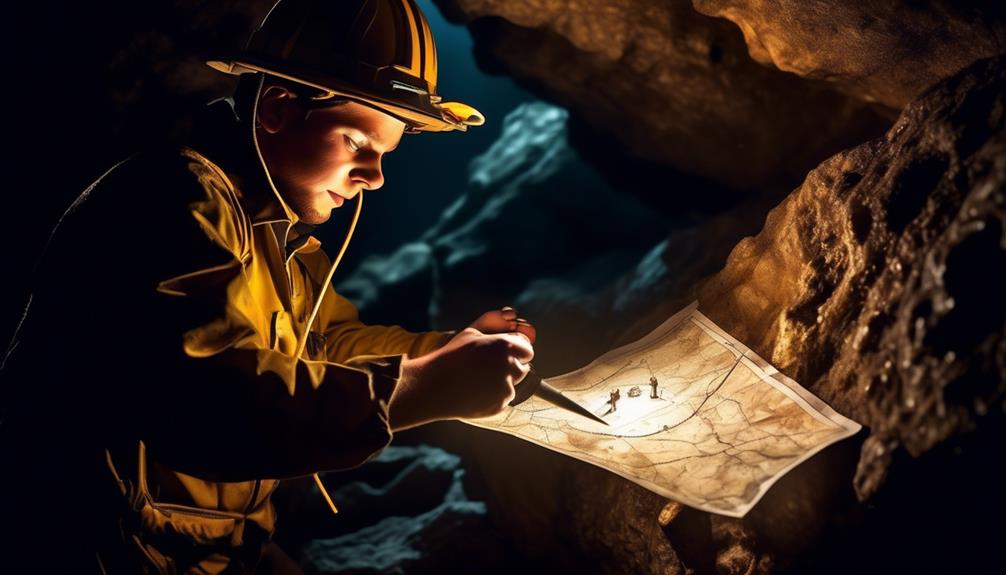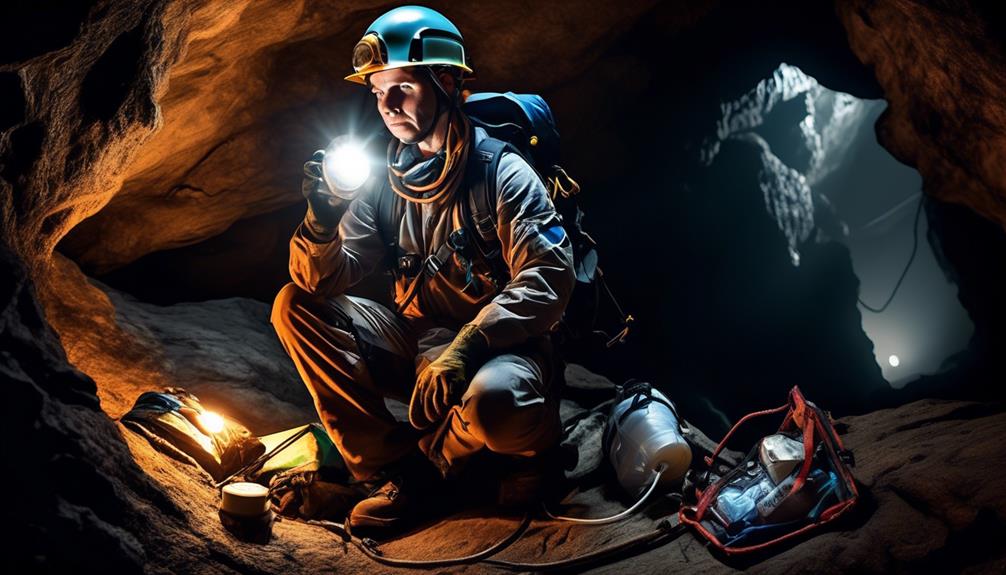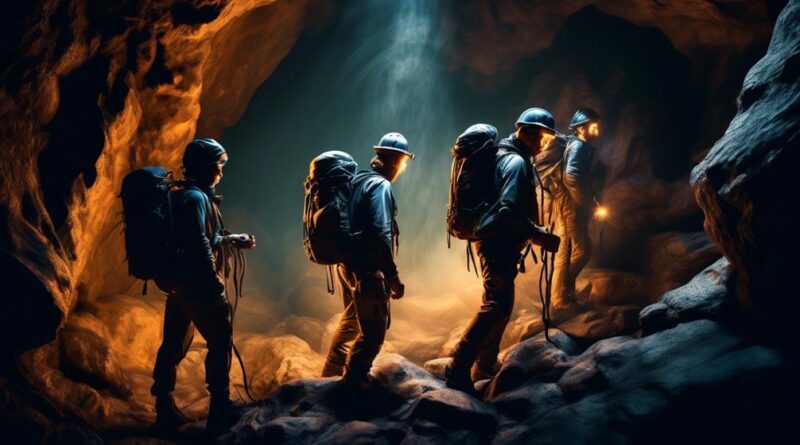Why Should Adventure Travelers Try Spelunking?
Have you ever wondered what lies beneath the surface of the earth, waiting to be discovered? The idea of exploring underground caves may seem daunting at first, but there are compelling reasons why adventurous travelers should consider spelunking.
From the thrill of navigating through intricate passageways to the awe-inspiring beauty of underground formations, spelunking offers a unique and immersive experience that can't be replicated anywhere else.
But there's more to it than just the allure of the unknown. As you contemplate taking on this exciting challenge, consider the multitude of benefits that come with delving into the depths of the earth.
Safety Precautions
Before embarking on a spelunking adventure, it's essential to prioritize safety by thoroughly preparing and equipping yourself. Start by ensuring that you have all the necessary gear by following a comprehensive equipment checklist. This includes a reliable helmet, headlamp with extra batteries, sturdy footwear, gloves, and a harness if you plan on exploring vertical caves.
It's crucial to undergo proper training programs to learn essential skills such as rope techniques, navigation, and emergency procedures. Familiarizing yourself with cave exploration and group dynamics is also vital. Understanding how to navigate through narrow passages, climb over obstacles, and work effectively within a group will significantly enhance your safety and overall experience.
When it comes to cave exploration, group dynamics play a significant role in ensuring everyone's safety. Before delving into the caves, establish a clear plan with your group, including communication signals and emergency protocols. Assign roles and responsibilities to each member, and ensure that everyone is comfortable with the planned route and level of difficulty. Regular communication among the group is crucial to maintaining cohesion and addressing any concerns that may arise during the expedition.
Essential Gear
To ensure a safe and successful spelunking adventure, it's crucial to have the essential gear in place. When venturing into the depths of caves and caverns, proper lighting equipment is essential. A reliable headlamp with extra batteries is a must-have. It allows you to keep your hands free while navigating through the dark and narrow passages. Additionally, carrying a backup light source such as a handheld flashlight is advisable in case of any unforeseen circumstances.
Protective clothing is another vital component of spelunking gear. A durable and comfortable helmet is essential to protect your head from low ceilings and potential falling debris. Opt for a helmet specifically designed for caving, as it offers better protection against impacts. Moreover, wearing sturdy and supportive footwear with a good grip is crucial to navigate through slippery and uneven terrain inside the caves.
In addition to the helmet and footwear, wearing suitable clothing is paramount. Choose moisture-wicking and quick-drying clothing to stay comfortable, as caves can be damp and humid. Consider wearing layers to regulate your body temperature as cave environments can vary. It's also important to have sturdy gloves to protect your hands while maneuvering through rough surfaces and sharp rocks.
Having the right lighting equipment and protective clothing is non-negotiable when embarking on a spelunking adventure. By investing in these essential gear items, you can ensure a safer and more enjoyable experience exploring underground wonders.
Physical Fitness
Ensuring your physical fitness is essential for navigating the challenging terrain of caves and caverns during spelunking expeditions. Cave exploration demands a good level of physical fitness due to the strenuous nature of moving through tight spaces, climbing over rocks, and sometimes even swimming through underground rivers or pools. Being in good physical shape not only helps you cope with the physical demands of spelunking but also enhances your overall experience, allowing you to fully appreciate the awe-inspiring beauty that awaits within the depths of the Earth.
Engaging in spelunking can provide numerous fitness benefits. The intense physical activity involved in spelunking, such as climbing, crawling, and hiking, is a great full-body workout. It challenges your strength, endurance, flexibility, and agility. The uneven and often slippery terrain of caves requires a strong core, good balance, and muscular endurance, all of which contribute to overall physical fitness. Additionally, the mental focus and concentration required during cave exploration can enhance cognitive abilities and mindfulness, contributing to your overall well-being.
Prioritizing your physical fitness through regular exercise and strength training can significantly improve your spelunking experience. Incorporating activities like hiking, rock climbing, and yoga into your fitness routine can help prepare your body for the demands of cave exploration. By maintaining a good level of physical fitness, you can't only navigate through caves more effectively but also fully enjoy the remarkable experience of spelunking.
Choosing the Right Cave
When selecting a cave for spelunking, consider the geological features and accessibility to ensure a safe and enjoyable exploration experience. Cave exploration offers thrilling underground adventures, but it's crucial to choose the right cave to maximize your experience.
Start by researching the geological features of different caves. Look for caves with interesting formations such as stalactites, stalagmites, and underground rivers. These features not only make the spelunking experience more visually stunning but also indicate a cave's stability and potential hazards.
Accessibility is another key factor to consider. Some caves require advanced technical skills and equipment, while others are more suitable for beginners. Assess your own skill level and choose a cave that aligns with it. Additionally, consider the distance and difficulty of the approach to the cave entrance. A long, strenuous hike to reach the cave mightn't be ideal for everyone, especially if you're carrying spelunking gear.
Furthermore, safety should be a top priority when selecting a cave for spelunking. Research the history of the cave to ensure there are no records of accidents or dangerous conditions. It's also essential to check for any regulations or permits required for exploring the cave.
Navigation and Orientation

Consider familiarizing yourself with the layout of the cave and equipping yourself with appropriate navigational tools to confidently navigate through the underground terrain. When engaging in underground exploration, it's crucial to have a solid understanding of the cave's layout.
Start by studying available cave mapping resources, which can provide valuable information about passages, chambers, and potential hazards. Familiarizing yourself with these maps will greatly enhance your ability to navigate the cave system effectively.
Additionally, investing in a reliable compass and a durable headlamp is essential. These tools will assist you in maintaining your bearings and illuminating the path ahead as you venture through the dark and intricate passages of the cave.
As you embark on your spelunking adventure, remember to constantly reference your map and make note of distinctive features within the cave. Look for unique formations, junctions, or landmarks that can serve as reference points to prevent getting disoriented. By marking these key elements on your map, you'll create a personalized guide for navigating the cave, making it easier to backtrack or explore further.
It's also important to communicate your planned route with fellow explorers and regularly check in with each other to ensure everyone's safety.
Ultimately, prioritizing navigation and orientation during spelunking not only enhances the overall experience but also contributes to a safe and rewarding underground exploration.
Environmental Awareness
To maintain a safe and rewarding underground exploration experience, it's vital to remain environmentally aware as you navigate through the cave system. Conservation efforts are crucial in preserving these delicate underground ecosystems. As you venture through the caves, be mindful of your impact on the environment. Avoid disturbing the natural formations, such as stalactites and stalagmites, as they take centuries to form. By refraining from touching these formations, you contribute to the preservation of the cave's natural beauty for future generations of spelunkers to enjoy.
Wildlife preservation is also a key aspect of environmental awareness during spelunking. Many caves are home to unique and often fragile species. To protect these creatures and their habitats, it's important to minimize your impact. This includes refraining from littering, staying on designated paths, and avoiding loud noises that could disturb the cave's inhabitants. By respecting the wildlife within the cave, you play a vital role in ensuring the continued existence of these species.
In addition to being mindful of the immediate surroundings, consider the broader impact of spelunking on the environment. Support conservation efforts by staying informed about local initiatives and regulations regarding cave exploration. By being a responsible spelunker, you contribute to the sustainability of these natural wonders.
Ultimately, by prioritizing conservation and wildlife preservation, you can continue to enjoy the thrill of spelunking while minimizing your environmental footprint.
Emergency Preparedness

In the event of an emergency while spelunking, prioritize safety by familiarizing yourself with the cave's layout and potential exit points. It's crucial to have a basic understanding of first aid and carry a well-equipped first aid kit. In the case of minor injuries, being able to administer first aid promptly can prevent the situation from escalating. Additionally, ensure you have a reliable means of emergency communication, such as a whistle, flashlight, or two-way radio, to signal for help if needed.
When exploring caves, always be prepared with emergency shelter and survival techniques. Carrying a lightweight emergency blanket or shelter can provide insulation and protection from the elements if you become stranded. It's also essential to have basic survival tools such as a multi-tool, fire starter, and extra food and water supply in case of an unforeseen circumstance. Familiarize yourself with survival techniques applicable to cave environments, such as finding water sources or creating makeshift lighting.
Prioritizing emergency preparedness when spelunking can make a significant difference in ensuring your safety and the safety of others. By being proactive and equipping yourself with the necessary skills and tools, you can navigate potential emergencies with confidence and mitigate risks associated with cave exploration.
Responsible Caving
When planning your caving excursions, it's crucial to prioritize responsible behavior that minimizes impact on the cave environment. Responsible caving involves adhering to the principles of Leave No Trace and implementing conservation practices to ensure the preservation of these fragile underground ecosystems.
To practice Leave No Trace while caving, remember to minimize your impact by staying on designated trails and avoiding disturbing cave formations. Refrain from touching or leaning on stalactites, stalagmites, and other delicate features, as the oils and dirt from your skin can disrupt the natural processes that shape these formations over centuries. Additionally, it's essential to pack out all waste, including biodegradable items, to maintain the pristine condition of the cave and its surroundings.
Conservation practices play a vital role in responsible caving. This includes respecting wildlife within the cave, such as bats and other creatures that call these dark spaces their home. Be mindful of designated hibernation areas and avoid disturbing these sensitive habitats. Furthermore, take the time to educate yourself about the specific conservation efforts and regulations in place for the cave you plan to explore, and ensure that you comply with these guidelines to contribute to the preservation of these natural wonders.
Frequently Asked Questions
Can Spelunking Be a Suitable Activity for Someone With Claustrophobia?
Spelunking can be a thrilling way to confront claustrophobia. Overcoming fears through challenging activities like spelunking can be empowering.
The therapy benefits of facing your fears head-on can lead to increased confidence and a sense of accomplishment. While it may seem daunting, many people with claustrophobia have found that spelunking has helped them to manage and even overcome their fear of enclosed spaces.
Are There Any Age Restrictions for Participating in Spelunking Adventures?
Age restrictions for spelunking adventures vary, with some caves having minimum age requirements for safety reasons. Safety guidelines are crucial, ensuring that participants can navigate the cave's terrain and handle any potential challenges.
While spelunking can be accessible to a wide range of ages, fear management is essential, as the enclosed spaces can be daunting for some.
Always check with tour operators for specific age restrictions and guidelines.
What Are Some Common Misconceptions About Spelunking That People Should Be Aware Of?
Common misconceptions about spelunking can make people hesitant. However, with proper safety precautions and the right equipment, exploring caves can be thrilling and safe.
Some think spelunking is only for experienced adventurers, but there are beginner-friendly options. Many also fear getting lost, but with a guide and proper planning, this is unlikely.
It's important to educate yourself on the reality of spelunking to fully enjoy the experience.
How Do Spelunking Tours Contribute to Local Conservation Efforts and Community Development?
Spelunking tours contribute to local conservation efforts and community development by fostering a deeper appreciation for the natural environment and supporting the local economy.
Exploring caves provides firsthand exposure to the fragile and unique ecosystems, promoting a sense of stewardship and environmental responsibility.
Additionally, spelunking tours create job opportunities and stimulate tourism, ultimately benefiting the local community.
Are There Any Cultural or Historical Aspects of Spelunking That Travelers Should Be Aware of Before Embarking on a Caving Adventure?
Before embarking on a caving adventure, it's essential to be aware of the cultural significance and historical preservation associated with spelunking. Understanding the cultural context and historical importance of caves can enrich your experience and deepen your appreciation for the activity.
Additionally, taking safety precautions and being mentally prepared are crucial for a successful spelunking adventure. By being mindful of these aspects, you can fully immerse yourself in the adventure while respecting the historical and cultural significance of the caves.
Conclusion
So, if you're an adventure traveler looking for a thrill, spelunking is the perfect activity for you.
With the right safety precautions, essential gear, physical fitness, and environmental awareness, you can explore the hidden depths of the earth while experiencing an adrenaline rush like no other.
Just remember to always be prepared for emergencies and to practice responsible caving to ensure the preservation of these natural wonders for future generations.
Happy exploring!
